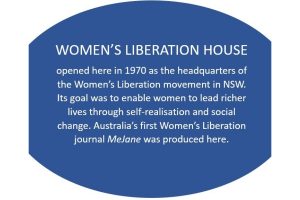Ian Stephenson, President, Bulletin 4/2022, June 2022
The fourth site nominated for a plaque is Elsie Women’s Refuge at 73-75 Westmoreland St, Glebe.
Elsie Refuge for Women and Children in Glebe was the first women’s refuge to open in Australia. It inspired hundreds of similar refuges to open, providing care, support and anonymity to women and children fleeing domestic violence. The bold and audacious actions of a few feminist women in Glebe in 1974 inaugurated a truly nationwide refuge movement for women and children.
Domestic and family violence against women and children was a central concern of second wave feminists. The issue was not recognised by the law, and there was little recourse for protection or escape for many women subject to this insidious and yet mostly unspoken, private abuse. Glebe was ’a base for the women’s movement, home to the Women’s Liberation Movement, which was anarchist in style, and focused on working in co-operative groups to show society better ways of achieving humane goals’ (Max Solling, Grandeur and Grit: A History of Glebe, Sydney: Halstead Press, NSW, 2007, p. 267).
In 1974 a group of Sydney Women’s Liberation members, led by Anne Summers with Jennifer Dakers and Bessie Guthrie, broke into two adjoining vacant houses, Elsie and Minnie, at 73 and 75 Westmoreland St on the Glebe Estate. Armed only with broomsticks, shovels and energetic determination, they changed the locks to establish residency and claimed squatter’s rights. On 16 March, the women declared Elsie Women’s Refuge and Night Shelter open as Australia’s first emergency safe haven for women and children subject to domestic violence. So began a remarkable and fearless social experiment, grounded in activism around feminism and housing campaigns, which would inspire services for women and children experiencing domestic violence across New South Wales and Australia.
The Elsie collective was adamant about the need to raise public consciousness about domestic violence, and one of the first things they did after occupying and securing the Glebe premises was to call the media. They had two aims: first, to advertise the service to the women who needed their help, and second, to educate the wider public about the issue of domestic violence. Anne Summers has recalled the ignorance of reporters who turned up to interview these feminist pioneers but ‘couldn’t really understand what all the fuss was about’. However, within six weeks of opening, Elsie had provided shelter to 48 women and 35 children, proving how important it was.
Sources: This article was condensed from Catie Gilchrist, Forty years of the Elsie Refuge for Women and Children, Dictionary of Sydney. Other information is from Guthrie House and the Victorian Women’s Trust.










There are no comments yet. Please leave yours.